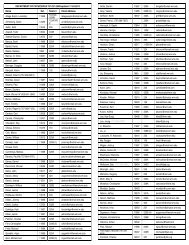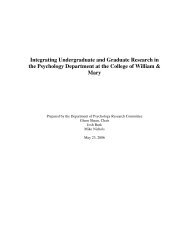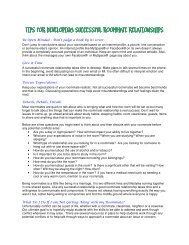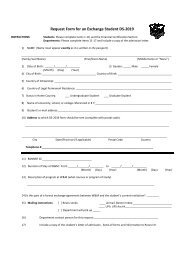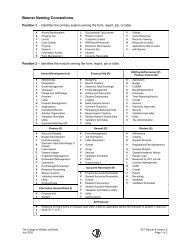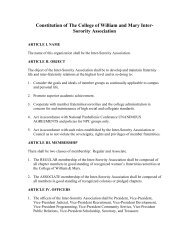WH-‐B48: The Holocaust from a Victim's Perspective Don Schilling ...
WH-‐B48: The Holocaust from a Victim's Perspective Don Schilling ...
WH-‐B48: The Holocaust from a Victim's Perspective Don Schilling ...
Create successful ePaper yourself
Turn your PDF publications into a flip-book with our unique Google optimized e-Paper software.
her miraculous survival and liberation by American troops-‐-‐including the man who was to become her husband-‐-‐in Volary, Czechoslovakia, in 1945. • Leitner, Isabella & Irving. Isabella: From Auschwitz to Freedom. New York: Anchor Books, 1994. (D804.3 .L453 1994) With the assistance of her husband, Leitner merges and re-‐works her previously published Fragments of Isabella and Saving the Fragments to produce an soul-‐stirring memoir that recounts the struggle of this young Hungarian and her family to survive Auschwitz during the last year of the war. • Lengyel, Olga. Five Chimneys. Chicago: Academy Chicago Publishers, 1995. (D 805.5 .A96 L4613 1995) Originally published in 1946, this memoir tells the story of the author’s year in Auschwitz and the harrowing death march after the camp was abandoned in January 1945. Provides detailed insight into many aspects of camp life, including the author’s work in the camp infirmary. • Müller, Filip. Eyewitness Auschwitz: Three Years in the Gas Chambers. Chicago: I.R. Dee, 1999. (D 805.5 .A96 M8513 1999) Eyewitness account of Auschwitz as told by the author, who worked in the Sonderkommando, a unit of Jewish prisoners assigned to work in the gas chambers and crematoria. Testimony draws mainly upon the author’s personal recollection of work assignments. Includes an appendix of plans of the camp and a glossary. • Nel Siedlecki, Janusz, Krystyn Olszewski, and Tadeusz Borowski. We Were in Auschwitz. New York: Welcome Rain Publishers, 2000. (D 805.5 .A96 N45 2000) English translation of one of the earliest accounts of life in Auschwitz, originally published in Polish in 1946. Presents a short description of the camp, a glossary of terms used by prisoners in Auschwitz, and 14 stories illuminating various aspects of life in the camps. Includes insights into the evolving nature of camp life, as the three authors each experienced the camp at different times during the war. • Neurath, Paul Martin. <strong>The</strong> Society of Terror: Inside the Dachau and Buchenwald Concentration Camp. Boulder, CO: Paradigm Publishers, 2005. (D 805.5 D33 N49 2005) Recounts the author’s personal experience in as well as a historical analysis of two concentration camps. Describes daily life in camps, types of prisoners, and camp administration, and details the complex social relations between prisoners and guards and among groups of prisoners in the two camps. Includes an afterword written after the author’s death by fellow scholars and a bibliography. • Niewyk, <strong>Don</strong>ald, editor. Fresh Wounds: Early Narratives by <strong>Holocaust</strong> Survivors. Chapel Hill, NC: University of North Carolina Press, 1998. (D 804.195 .F74 1998) Collection of survivor testimonies recorded by David Boder in 1946 that provide first-‐hand accounts of life in various camps. Includes a glossary of terms and camps, an index, and a bibliography. 5
• Novac, Ana. <strong>The</strong> Beautiful Days of My Youth: My Six Months in Auschwitz and Plaszow. New York: Henry Holt, 1997. (D 805 .P7 N6513 1997) Personal journal of a Jewish teenager <strong>from</strong> Transylvania originally maintained on scraps of paper during her internment in various work and concentration camps, including Auschwitz. • Nyiszli, Miklós. Auschwitz: A Doctor's Eyewitness Account. New York : Fawcett Crest, 1961. (D 805.5 .A96 N9513 1961) Relates the experiences of a Jewish physician who became the personal research pathologist of Dr. Josef Mengele in order to survive. Provides first-‐hand insight into some of the more macabre aspects of the camp, including medical experiments on prisoners, as well as the ethical dilemmas that faced many of the prisoners, like Dr. Nyiszli, who had to work with the Nazis in order to survive. Originally published in English in 1960. • Rubin, Agi & Henry Greenspan. Reflections: Auschwitz, Memory, and A Life Recreated. St. Paul, MN: Paragon House, 2006. (DS135.U43 R7947 2006) Reflections is a book of memories, but it is equally a book about memory. <strong>The</strong> fruit of a twenty-‐five year conversation between Rubin, a <strong>Holocaust</strong> survivor, and Greenspan, a psychologist-‐playwright, and extending a diary that Rubin began at liberation, Reflections describes the fate of <strong>Holocaust</strong> memories over the course of an entire life. "New experiences reflect old ones," Rubin notes. "<strong>The</strong>y put them in a different light, or a different darkness." <strong>The</strong>se reflections, the continuing dialogue between past and present, are the story this book tells about Auschwitz, memory, and a life recreated. • Shelley, Lore, editor. Auschwitz: <strong>The</strong> Nazi Civilization: Twenty-‐three Women Prisoners' Accounts: Auschwitz Camp Administration and SS Enterprises and Workshops. Lanham, MD: University Press of America, 1992. (D 805.5 .A96 A9659 1992) Compilation of testimonies <strong>from</strong> twenty-‐three female prisoners that forms a large narrative covering types of work assignments. Describes administrative and office work, the laundry detail, mending, tailoring, cleaning, and work in a grain warehouse. Includes appendices covering SS biographical information and the “Auschwitz Song,” a glossary, bibliography, and an index. • Vrba, Rudolf. Escape <strong>from</strong> Auschwitz: I Cannot Forgive. New York: Grove Press, 1986. (D 805.5 .A96 V73 1986) Provides a detailed account of life in Auschwitz written by a former prisoner who worked in the Kanada complex, processing clothing and goods taken <strong>from</strong> prisoners who had been sent to the gas chambers. <strong>The</strong> author was one of the few prisoners who successfully escaped <strong>from</strong> the camp; he and fellow prisoner Alfréd Wetzler smuggled out detailed plans and descriptions of the camp to pass along to anti-‐Nazi partisans. 6
WORKS BY OR ABOUT PRIMO LEVI • Angier, Carole. <strong>The</strong> Double Bond: Primo Levi, a Biography. New York: Farrar, Straus, Giroux, 2002. (PQ4872.E8 Z55 2002) Ten years in the making, this book alternates between chapters of straightforward narration, with a close reading of Levi's works, and chapters of Angier's personal observations and thoughts about Levi. <strong>The</strong> passages on Auschwitz and Levi's suicide are invaluable additions to our understanding of this important author's work. Considered the definitive biography of Levi by many although some readers will find over 800 pages of narrative more than they want to tackle. • Anissimov, Myriam. Primo Levi: <strong>The</strong> Tragedy of an Optimist. Woodstock, NY: Overlook Press, 1999. (PQ4872.E8 Z5613 1999) A Paris-‐based writer and journalist, Anissimov carefully researched Levi’s life and writings. Her clear, concise work proves to be an invaluable resource for scholars and researchers, but readers who desire some insight into Levi's personality may be disappointed. After reading this 450-‐page book, one will have gained an excellent understanding of Levi's work, but little of him. • Levi, Primo. Survival in Auschwitz: <strong>The</strong> Nazi Assault on Humanity. New York: Collier Books, 1986. (PQ4872.E8 S4313 1986) Originally published in under the title If This is a Man in 1958. Presents a series of 17 chapters, each illuminating a particular event or aspect of life in the camps that show the daily Nazi assault on humanity through large and small acts of cruelty. • Levi, Primo. If Not Now, When? New York: Penguin Books, 1986. (PQ4872.E8 S413 1986) In this work of fiction, based on a true story, Levi chronicles the actions of a band of Jewish partisans as they wage a personal war of revenge against the Nazis in Eastern Europe. <strong>The</strong>ir ultimate goal is to get to Italy and <strong>from</strong> there to Palestine. • Levi, Primo. Moments of Reprieve: A Memoir of Auschwitz. New York: Penguin Books, 1987. (PQ4872.E8 Z4713 1987) This memoir consists of fifteen portraits of prisoners he encountered in Auschwitz, “…human figures [who, as he noted in the book’s Preface] especially stood out against that tragic background: friends, people I’d traveled with even adversaries…the ones in whom (if only for a moment) I had recognized the will and capacity to react, and hence a rudiment of virtue.” • Levi, Primo. <strong>The</strong> Drowned and the Saved. New York: Vintage Books, 1989. (D804.3 L4813 1989) In this book, the last to be written before his death, Levi wrestles with the meaning of the <strong>Holocaust</strong> after forty years. As noted in the Preface, Levi “…tr[ies] to answer the most urgent question, the question that torments all those who have happened to read our accounts: How much of the concentration camp world is dead and will not return…? How much is back or coming back? What can each of us do so that in this world pregnant with threats at least this threat will be nullified? “ 7
• Levi, Primo. <strong>The</strong> Periodic Table. New York: Schocken Books, 1984. (PQ 4872.E8 S513 1984) Largely a memoir of the years before and after Levi’s Auschwitz experience, this book tells of the Piedmontese Jewish community <strong>from</strong> which he came, of his years as a student and young chemist at the inception of the Second World War, and of his investigations into the nature of the material world. Each chapter uses an element <strong>from</strong> the periodic table as a metaphor for a tale that unfolds in clear, precise, unfailingly beautiful prose. • Levi, Primo. <strong>The</strong> Reawakening. New York: Collier Books, 1993. (D804.3 .L48413 1993) First published in English in 1965, <strong>The</strong> Reawakening is Levi's bestselling sequel to Survival in Auschwitz. It is inspiring story of Levi's liberation <strong>from</strong> Auschwitz and his strange and eventful journey home to Italy by way of the Soviet Union, Hungary, and Romania. • Thomson, Ian. Primo Levi: A Life. New York: London: Hutchinson, 2002. (PQ4872.E8 Z88 2002). A comprehensive biography (over 600 pages) drawing on exclusive access to family members and previously unseen correspondence. In addition to examining the stages of Levi’s life, Thomson presents him in all his facets: his fondness for Louis Armstrong and fast cars, his insomnia and severe bouts of depression, and his passion for life and ideas. *Much of this bibliography comes <strong>from</strong> the United States <strong>Holocaust</strong> Memorial Museum: Daily Life in the Concentration Camps website for which the URL is: http://www.ushmm.org/research/research-‐in-‐collections/search-‐the-collections/bibliography/daily-‐life-‐in-‐the-‐concentration-‐campsI have added deleted some works and added others. Also of interest is <strong>The</strong> International Primo Levi Studies Center. URL is: http://www.primolevi.it/Web/English/Instruments/<strong>The</strong>_Center 8


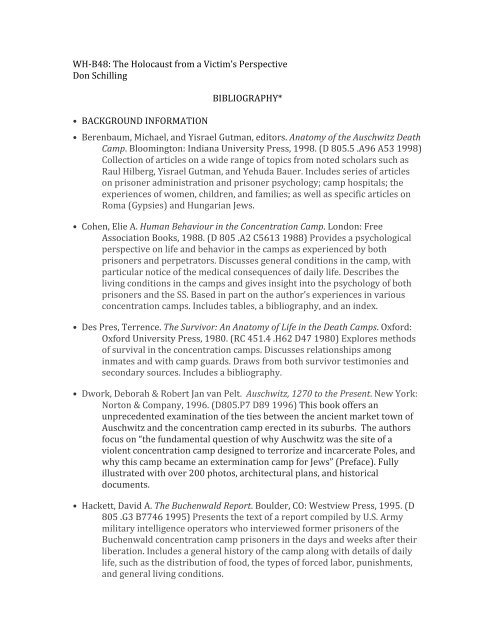
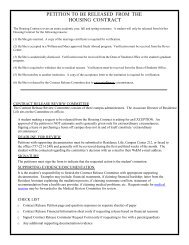
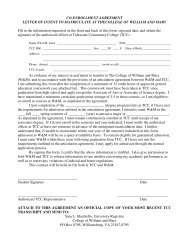
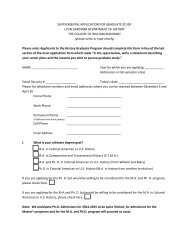

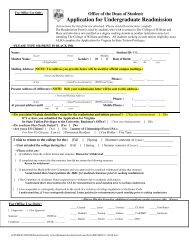

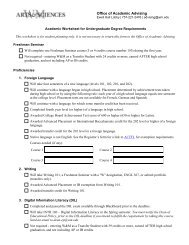
![Course Selection Guidebook [pdf] - College of William and Mary](https://img.yumpu.com/46952524/1/190x245/course-selection-guidebook-pdf-college-of-william-and-mary.jpg?quality=85)
